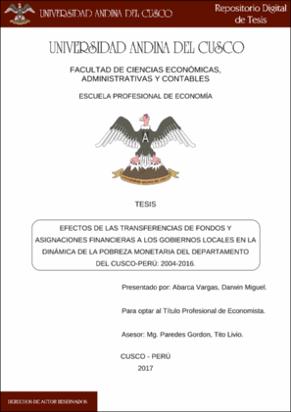| dc.contributor.advisor | Paredes Gordón, Tito Livio | |
| dc.contributor.author | Abarca Vargas, Darwin Miguel | |
| dc.date.accessioned | 2017-11-29T16:05:51Z | |
| dc.date.available | 2017-11-29T16:05:51Z | |
| dc.date.issued | 2017-10-31 | |
| dc.identifier.uri | https://hdl.handle.net/20.500.12557/1128 | |
| dc.description.abstract | El presente estudio fue elaborado en función a la necesidad de comprobar la
interrogante ¿En qué medida las transferencias de fondos y asignaciones financieras destinados a los gobiernos locales influyeron en la dinámica de la pobreza monetaria en el departamento del Cusco, comprendidos entre los periodos del 2004 al 2016?; porque, la reducción de la tasa de pobreza monetaria nacional fue significativa en los periodos mencionados y el incremento de las transferencias de fondos y asignaciones financieras tuvo un incremento sustancial; también, en los periodos indicados. Este incremento fue debido en su gran mayoría, a las actividades extractivas de origen mineral y gasíferas desarrolladas en nuestro departamento, los mismos que, en esos años tuvieron un papel significativo en la región; y para proponer una respuesta se planteó identificar los efectos de las transferencias de fondos y asignaciones
financieras a los gobiernos locales y su influencia en la dinámica de la pobreza monetaria para el departamento del Cusco, comprendidos entre los periodos del 2004 al 2016. Los resultados primarios de esta identificación suponen que las mayores transferencias de fondos y asignaciones financieras a los gobiernos locales generaron una disminución significativa en la pobreza monetaria, para el departamento del Cusco, comprendido en el periodo de los años 2004 al 2016, como una hipótesis general. La metodología utilizada, se plantea desde la perspectiva descriptiva y correlacional, utilizando para la primera, diferentes teorías relacionadas a nivel internacional como nacional; y para la segunda, se efectuó cálculos con la ayudo del software STATA, y para describir el grado de significancia de los resultados, se tomó como base las fuentes de los censos de 1993 al 2007 y Encuesta Nacional de Hogares (ENAHOS) de diferentes años y también se utilizó fuentes recuperadas de otras plataformas virtuales que el gobierno ofrece, y se complementó con las metodologías brindadas por el Ministerio de Economía y Finanzas, por todo lo mencionado, se llegó a resultados no esperados, pero satisfactorios en el grado de significancia, cabe mencionar que este trabajo está basado en la tesis magistral denominado “Efectos del Gasto Público sobre la Pobreza Monetaria
en el Perú: 2004-2012”, del magister en economía Nilton Marcelo Quiñones Huayna. | es_PE |
| dc.description.abstract | The present study was elaborated in function of the need to verify the question to the extent to which the transfers of funds and financial allocations destined to the local governments influenced in the dynamics of the monetary poverty in the department of Cusco, between the periods of 2004 to 2016, because the reduction of the national monetary poverty rate was significant in the mentioned periods and the increase of the transfers of funds and financial allocations had a substantial increase; also, in the indicated periods. This increase was due in large part to the mineral and gas extraction activities carried out in our department, which, in those years, played a significant role in the region; and to propose a response it was proposed to identify the effects of transfers of funds and financial allocations to local governments and their influence on the dynamics of monetary poverty for the department of Cusco between the periods of 2004 to 2016. The primary results of this identification suppose that the greater transfers of funds and financial allocations to the local governments generated a significant reduction in the monetary poverty, for the department of Cusco, included in the period from the years 2004 to 2016, like a general hypothesis. The methodology used, is presented from the descriptive and correlational perspective, using for the first, different theories related at the international level as national; and for the second, calculations were made with the STATA software help, and to describe the degree of significance of the results, the sources of the censuses from 1993 to 2007 and the National Household Survey (ENAHOS) of different years and also used sources retrieved from other virtual platforms that the government offers, and was complemented by the methodologies provided by the Ministry of Economy and
Finance, for all of the above, we achieved unexpected but satisfactory results in the degree of significance, it is worth mentioning that this work is based on the master thesis entitled “Effects of Public Spending on Monetary Poverty in Peru: 2004-2012“, by the magister in economics Nilton Marcelo Quiñones Huayna. | en_US |
| dc.description.uri | Tesis | es_PE |
| dc.format | application/pdf | es_PE |
| dc.language.iso | spa | es_PE |
| dc.publisher | Universidad Andina del Cusco | es_PE |
| dc.rights | info:eu-repo/semantics/openAccess | es_PE |
| dc.rights.uri | https://creativecommons.org/licenses/by-nc-nd/2.5/pe/ | es_PE |
| dc.source | Universidad Andina del Cusco | es_PE |
| dc.source | Repositorio Institucional - UAC | es_PE |
| dc.subject | Transferencias | es_PE |
| dc.subject | Fondos | es_PE |
| dc.subject | Asignaciones | es_PE |
| dc.subject | Pobr eza | es_PE |
| dc.title | Efectos de las transferencias de fondos y asignaciones financieras a los gobiernos locales en la dinámica de la pobreza monetaria del departamento del Cusco-Perú:2004-2016. | es_PE |
| dc.type | info:eu-repo/semantics/bachelorThesis | es_PE |
| thesis.degree.name | Economista | es_PE |
| thesis.degree.grantor | Universidad Andina del Cusco. Facultad de Ciencias Económicas, Administrativas y Contables | es_PE |
| thesis.degree.level | Titulo Profesional | es_PE |
| thesis.degree.discipline | Economía | es_PE |


